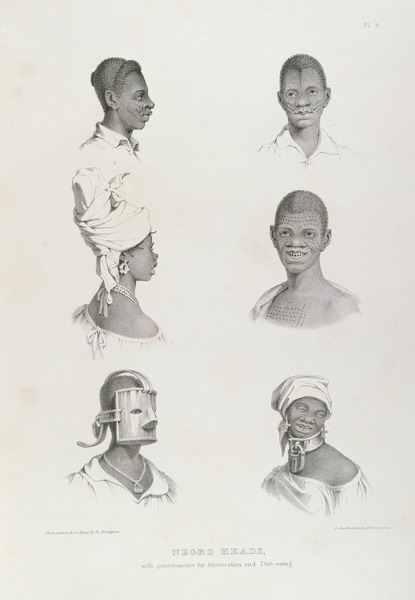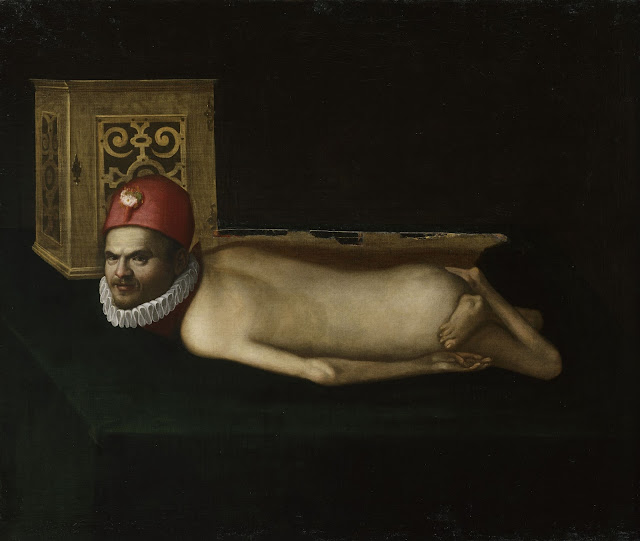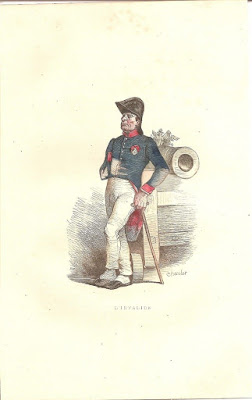Blindness and ‘The object of art-in-between’. Towards cosmopolitical encounters in museological settings
By Joyce
Leysen
“What I thought was funny … they didn’t see those little faces …”
“No, they didn’t see them, they didn’t know. They weren’t quite sure what they were for, and you felt, oh this is a little face.”
“And when she said that, I thought ‘Oh yes, look here, a little nose and …!’ and all of a sudden, the picture is more clear.”
“Those are such interesting things I think, you can’t see it, yet, you can feel it.”
(excerpt from conversation: three persons (with and without visual impairments) talking about their art experience in a Brussels museum, 2014, my translation)
During the research, that on the one hand tried to get to an understanding of how people with visual impairments experience art, and on the other hand wanted to introduce and explore the cosmopolitical proposal in museological settings, we visited the Royal Museum of Art and History in Brussels, Museum M in Leuven, and the Art Studios of conceptual artist Koen Vanmechelen in Hasselt. (For each visit the number of people differed. We went with seven people with and without visual impairments (and a guide dog) to the Art Studios. Ten people (of whom five with visual impairments) and two guide dogs went to the Brussels museum. A large group of twenty people with and without visual impairments went to Museum M. This group was guided by two guides, one with and one without visual impairment.)
In the course of those visits, it appeared that experiencing art together engendered chances to open encounters. Especially through a setting I came to call ‘the object of art-in-between’; a setting in which the object of art was thought of as an ‘interpreter’ in the relation between people with and without (visual) impairments. It entailed the object of art to be at the center of attention during an art tour (for instance through haptic experience), rather than the guide’s descriptive explanation (like during verbal description tours). Differently put, it was experiencing the artefact that guided the interaction between people with and without visual impairments. Or as a blind participant said: “That is a good example of art being an ‘interpreter’. You’ve got a medium through which…you can have a conversation and get into real contact” (excerpt from group conversation, Art Studio K. Vanmechelen, 2014, my translation).
The art-in-between setting also seemed to open up a space for learning from each other. A space in which learning experiences weren’t targeted at some learning goal, but allowed people with and without visual impairments to jointly come to an understanding of art that was more nuanced (than through visual or auditory perception alone), and reached beyond the own initial idea of the work of art.
The quote at the beginning of this piece is an illustration of this. The people with visual impairments thought it was funny that the seeing people had not noticed the specific constellation of what seemed to be little pockmarks on the surface of the vase. The guide had tried to describe this, but many of the blind people said they still didn’t see the picture. This changed during what happened when they haptically experienced the vase and its surface. Through the observation of one person touching the vase and making the remark that “it was like a little face”, all the others, both seeing and blind people, started to look and think about the vase in a way that was different than during the tour’s verbal descriptions. As the next person touching the vase said: “Oh yes, look here, a little nose and …!” and “all of a sudden, the picture is more clear”. The point here is not so much that this specific constellation was indeed a little face, but rather, that we all came to an understanding of this object of art we could not have reached without each other and without the experience of the artefact.
Of course, not all is said here, and a lot still needs investigation. Yet what became clear for me, is that museums do have opportunities to shape their settings in ways that not only bring together works of art, but also people.
(The entire research has been published in 2015 in my book entitled Staar verder. Naar een kosmopolitisch begrijpen van de relatie tussen blindheid, kunst en maatschappij [Dutsch/Garant Publishers].
“What I thought was funny … they didn’t see those little faces …”
“No, they didn’t see them, they didn’t know. They weren’t quite sure what they were for, and you felt, oh this is a little face.”
“And when she said that, I thought ‘Oh yes, look here, a little nose and …!’ and all of a sudden, the picture is more clear.”
“Those are such interesting things I think, you can’t see it, yet, you can feel it.”
(excerpt from conversation: three persons (with and without visual impairments) talking about their art experience in a Brussels museum, 2014, my translation)
The above quote comes from a conversation during a tour for people with visual impairments in a museum in Brussels (Belgium). Our group was, at that specific time, sitting in a separate room where the persons with visual impairments were allowed to haptically experience an ancient vase. Very much appreciated by the group.
A dip in the museum's history shows that for thirty years already the museum staff provides for activities that specifically target the group of people with visual impairments. Today the policy of this so called Museum for Blind People (my own translation) is changed from organizing activities in separate rooms to the organization of customized tours for people with visual impairments within the regular museum circuit (see http://www.kmkg-mrah.be/nl/blinden-en-slechtzienden-0, consulted October 8, 2017).
Great, you might think, especially if you consider the following quote of a woman with a severe visual impairment who often went to the Museum for blind people: "In itself, I don't like the idea: 'We are going to that room alone.' You could sit there, and touch things. But you didn't have the feeling of going to an exhibition."
(excerpt from group conversation, Leuven, 2014, my translation).
For this person, being able to touch an object of art in a separate museum room did not evoke the feeling of experiencing art in a museum sphere. Though she recognized some advantages of fully separate art activity, she did express a domain and relating to the museum's public exhibitions. In other words, she wanted to have the feeling of being a museum visitor, as all other (seeing) people coming to the museum for an exhibition.
The shift in this museum’s policy to customized tours for people with visual impairments was not an isolated case.
Steered by the Convention on the Rights of Persons with Disabilities, ratified in Belgium in the summer of 2009 (see https://treaties.un.org/Pages/ViewDetails.aspx?src=TREATY&mtdsg_no=IV-15&chapter=4&clang=_en), museums worked to adapt their policy with regard to accessibility for people with disabilities.
The provision of personal assistance, uniform and clear signaling, tours with verbal description, and allowing guide dogs to enter the museum are but a few examples illustrating a concern for improved accessibility for people with visual impairments.
Of course not all museums are working at the same pace towards accomplishing such measures. Also, from the participatory research with people with visual impairments in 2014, it became clear that a discrepancy existed between several objectives in museum policy texts regarding accessibility for people with disabilities, and how these objectives were actually carried out and followed up in museological reality. Measures to improve art accessibility for people with visual disabilities through digital media, for instance, are in many cases devised by people without visual disabilities. This often leads to the overlooking of barriers for people with visual disabilities in the use of these media. Nonetheless, it does seem fair to say there is some raised awareness regarding the accessibility issue and inclusion perspectives. Improved accessibility measures and customized tours might raise the number of museum visitors with disabilities.
As mentioned, museum policy is aiming towards setting up activities for specific target groups, such as people with visual impairments, people with physical impairments, but also people with dementia, or mental disabilities. Trying to meet the needs of people with disabilities is of course a good thing, and even a necessary condition in the organization of adapted programs.
The point is, however, that target group policy still separates people with and without disabilities from each other, while at the same time, museum policy intents to aim for museums to be a place of encounter. (policy documents, websites, annual reports, and folders of thirteen museums in Flanders and Brussels were investigated). This is why I think several aspects regarding target group policy can be rethought: the way museums shape their tours and activities for people with disabilities does not seem to enhance the relation between people with and without disabilities. How then, can this be addressed? One possible answer to this question might be the research’s cosmopolitical proposal that considered the object of art as a mediator in a possible cosmopolitical relationship between people with and without visual impairments. Blindness, in this proposal, is not regarded as a person’s ‘defining characteristic’, nor is it put at the center of attention. It is, rather, considered as an invitation to an open encounter between people with and without visual impairments.
A dip in the museum's history shows that for thirty years already the museum staff provides for activities that specifically target the group of people with visual impairments. Today the policy of this so called Museum for Blind People (my own translation) is changed from organizing activities in separate rooms to the organization of customized tours for people with visual impairments within the regular museum circuit (see http://www.kmkg-mrah.be/nl/blinden-en-slechtzienden-0, consulted October 8, 2017).
(excerpt from group conversation, Leuven, 2014, my translation).
For this person, being able to touch an object of art in a separate museum room did not evoke the feeling of experiencing art in a museum sphere. Though she recognized some advantages of fully separate art activity, she did express a domain and relating to the museum's public exhibitions. In other words, she wanted to have the feeling of being a museum visitor, as all other (seeing) people coming to the museum for an exhibition.
The shift in this museum’s policy to customized tours for people with visual impairments was not an isolated case.
Steered by the Convention on the Rights of Persons with Disabilities, ratified in Belgium in the summer of 2009 (see https://treaties.un.org/Pages/ViewDetails.aspx?src=TREATY&mtdsg_no=IV-15&chapter=4&clang=_en), museums worked to adapt their policy with regard to accessibility for people with disabilities.
The provision of personal assistance, uniform and clear signaling, tours with verbal description, and allowing guide dogs to enter the museum are but a few examples illustrating a concern for improved accessibility for people with visual impairments.
Of course not all museums are working at the same pace towards accomplishing such measures. Also, from the participatory research with people with visual impairments in 2014, it became clear that a discrepancy existed between several objectives in museum policy texts regarding accessibility for people with disabilities, and how these objectives were actually carried out and followed up in museological reality. Measures to improve art accessibility for people with visual disabilities through digital media, for instance, are in many cases devised by people without visual disabilities. This often leads to the overlooking of barriers for people with visual disabilities in the use of these media. Nonetheless, it does seem fair to say there is some raised awareness regarding the accessibility issue and inclusion perspectives. Improved accessibility measures and customized tours might raise the number of museum visitors with disabilities.
As mentioned, museum policy is aiming towards setting up activities for specific target groups, such as people with visual impairments, people with physical impairments, but also people with dementia, or mental disabilities. Trying to meet the needs of people with disabilities is of course a good thing, and even a necessary condition in the organization of adapted programs.
The point is, however, that target group policy still separates people with and without disabilities from each other, while at the same time, museum policy intents to aim for museums to be a place of encounter. (policy documents, websites, annual reports, and folders of thirteen museums in Flanders and Brussels were investigated). This is why I think several aspects regarding target group policy can be rethought: the way museums shape their tours and activities for people with disabilities does not seem to enhance the relation between people with and without disabilities. How then, can this be addressed? One possible answer to this question might be the research’s cosmopolitical proposal that considered the object of art as a mediator in a possible cosmopolitical relationship between people with and without visual impairments. Blindness, in this proposal, is not regarded as a person’s ‘defining characteristic’, nor is it put at the center of attention. It is, rather, considered as an invitation to an open encounter between people with and without visual impairments.
 |
| © Marc Van Langendonck Haptic art experience during a customized tour on Vesalius for people with visual impairments in Museum M (museum for contemporary and old art), Leuven (Belgium). |
During the research, that on the one hand tried to get to an understanding of how people with visual impairments experience art, and on the other hand wanted to introduce and explore the cosmopolitical proposal in museological settings, we visited the Royal Museum of Art and History in Brussels, Museum M in Leuven, and the Art Studios of conceptual artist Koen Vanmechelen in Hasselt. (For each visit the number of people differed. We went with seven people with and without visual impairments (and a guide dog) to the Art Studios. Ten people (of whom five with visual impairments) and two guide dogs went to the Brussels museum. A large group of twenty people with and without visual impairments went to Museum M. This group was guided by two guides, one with and one without visual impairment.)
In the course of those visits, it appeared that experiencing art together engendered chances to open encounters. Especially through a setting I came to call ‘the object of art-in-between’; a setting in which the object of art was thought of as an ‘interpreter’ in the relation between people with and without (visual) impairments. It entailed the object of art to be at the center of attention during an art tour (for instance through haptic experience), rather than the guide’s descriptive explanation (like during verbal description tours). Differently put, it was experiencing the artefact that guided the interaction between people with and without visual impairments. Or as a blind participant said: “That is a good example of art being an ‘interpreter’. You’ve got a medium through which…you can have a conversation and get into real contact” (excerpt from group conversation, Art Studio K. Vanmechelen, 2014, my translation).
 |
| © Joyce Leysen
Haptically
experiencing conceptual art of artist Koen Vanmechelen, in
Vanmechelen’s Art Studios, Hasselt (Belgium).
|
The art-in-between setting also seemed to open up a space for learning from each other. A space in which learning experiences weren’t targeted at some learning goal, but allowed people with and without visual impairments to jointly come to an understanding of art that was more nuanced (than through visual or auditory perception alone), and reached beyond the own initial idea of the work of art.
The quote at the beginning of this piece is an illustration of this. The people with visual impairments thought it was funny that the seeing people had not noticed the specific constellation of what seemed to be little pockmarks on the surface of the vase. The guide had tried to describe this, but many of the blind people said they still didn’t see the picture. This changed during what happened when they haptically experienced the vase and its surface. Through the observation of one person touching the vase and making the remark that “it was like a little face”, all the others, both seeing and blind people, started to look and think about the vase in a way that was different than during the tour’s verbal descriptions. As the next person touching the vase said: “Oh yes, look here, a little nose and …!” and “all of a sudden, the picture is more clear”. The point here is not so much that this specific constellation was indeed a little face, but rather, that we all came to an understanding of this object of art we could not have reached without each other and without the experience of the artefact.
Of course, not all is said here, and a lot still needs investigation. Yet what became clear for me, is that museums do have opportunities to shape their settings in ways that not only bring together works of art, but also people.
(The entire research has been published in 2015 in my book entitled Staar verder. Naar een kosmopolitisch begrijpen van de relatie tussen blindheid, kunst en maatschappij [Dutsch/Garant Publishers].
Recommended Citation:
Joyce Leysen (2017): "Blindness and 'The object of art-in-between.' Towards cosmopolitical encounters in museological settings. In: Public Disability History 2 (2017) 20.



